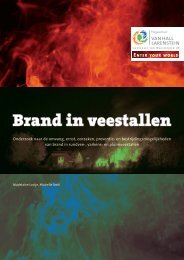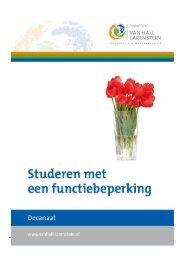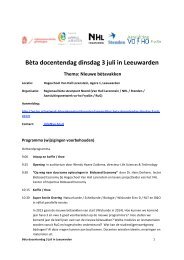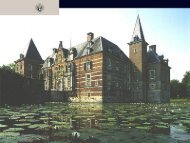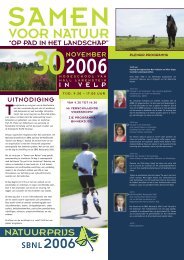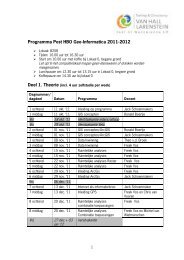Handbook International Timber Trade - Hogeschool Van Hall ...
Handbook International Timber Trade - Hogeschool Van Hall ...
Handbook International Timber Trade - Hogeschool Van Hall ...
You also want an ePaper? Increase the reach of your titles
YUMPU automatically turns print PDFs into web optimized ePapers that Google loves.
<strong>Handbook</strong> <strong>International</strong> <strong>Timber</strong> <strong>Trade</strong> 2006 ir. R.G. Wijers/ ir. J. Raggers (external use)<br />
1<br />
<strong>Handbook</strong> <strong>International</strong> <strong>Timber</strong> <strong>Trade</strong><br />
(Specialisation year 3 and 4)<br />
Larenstein University of Professional Education Major <strong>International</strong> <strong>Timber</strong><br />
<strong>Trade</strong><br />
Ir. R.G. Wijers<br />
Ir. J. Raggers<br />
Velp, January 2007<br />
Description and organisation of the<br />
Major <strong>International</strong> <strong>Timber</strong> <strong>Trade</strong>
Contents:<br />
1. Introduction<br />
2. Job profile description<br />
3. Overview of themes and credits (ECTS)<br />
4. Theme marketing of wood products (year 3, term 1, 2)<br />
5. Theme timber trade and wood science (year 3, term 2)<br />
5.1 Introduction in timber trade<br />
5.2 Wood science and technology<br />
6. Theme timber and timber trade (year 3, term 3)<br />
6.1 Organisation and commerce<br />
6.2 <strong>Timber</strong> trade and technology<br />
6.3 Wood quality and grading<br />
6.4 Engineered wood products<br />
6.5 Utilisation of timber<br />
6.6 Logistics<br />
7. Module description of practical training (year 3, term 4)<br />
8. Module description of practical training (year 4, term 1)<br />
9. Theme policies and business development (year 4, term 2)<br />
7.1 Certification and illegal harvesting<br />
7.2 Business developments<br />
10. Module description of thesis (year 4, term 3 and 4)<br />
<strong>Handbook</strong> <strong>International</strong> <strong>Timber</strong> <strong>Trade</strong> 2006 ir. R.G. Wijers/ ir. J. Raggers (external use)<br />
2
1. Introduction<br />
<strong>Handbook</strong> <strong>International</strong> <strong>Timber</strong> <strong>Trade</strong> 2006 ir. R.G. Wijers/ ir. J. Raggers (external use)<br />
3<br />
Wood is a unique material with unique properties. Not only is it much in demand for its usefulness and<br />
its beauty, it is also the ultimately renewable resource – no small advantage in a world whose<br />
population is still growing fast. Wood also represents a trade of enormous international scope and<br />
complexity. In fact, the flow of wood products is so great that it represents the world’s second largest<br />
flow of goods – one that involves long and complicated processes of transport, processing and<br />
manufacturing. Taken together, these factors represent a wealth of exciting international career<br />
opportunities in a sector that is in urgent need of skilled young people.<br />
This document describes the job opportunities and in brief the modules of the two-year international<br />
Bachelor course which is integrated within a four-year programme in Forest and Nature Management<br />
taught to Dutch students. It can also be attended as a top-up programme, or as part of another<br />
European Bachelor course. The objectives and topics of every course component and also information<br />
about the study material is given.<br />
In 2002, this education programme was initiated by Larenstein University of Professional Education<br />
and the forest- and timber industry of the Netherlands. Recent developments concerning the<br />
globalisation of the world markets and the age distribution of the professionals with in the Dutch<br />
timber and forestry sector, (a high percentage of workers on management level are above 45 years of<br />
age) results in a need of well oriented international professionals.<br />
2. Job profile description<br />
2.1 General characteristics of the profession<br />
Students who have successfully completed the programme <strong>International</strong> <strong>Timber</strong> <strong>Trade</strong> are working in<br />
the fields of purchasing/ selling and production of wood or wood based materials and the consultancy<br />
in certified wood products.<br />
Characterisation of companies for graduates:<br />
• Large and semi large timber trade companies focused on the international market.<br />
• Multinationals trading worldwide in timber products<br />
• National and international timber producing companies<br />
• Research and consultancy company in the field of certified timber<br />
Possible job-positions<br />
In the table shown below you can see the professional groups with the starting position:<br />
Professional group Starting position<br />
• Purchasing Assistant purchaser<br />
• Quality control Quality controller<br />
• Product manufacturing Product developer<br />
• Sales Salesman, assistant sales manager<br />
account manager<br />
• Certification Assistant project manager
After a number of years graduates can develop in different ways to<br />
become specialists or generalists. Job opportunities are sales<br />
managers, purchasers, account managers or head of departments or companies.<br />
Recent developments<br />
At this moment there are a number of developments going on. A few of them are:<br />
• Globalisation of markets of timber and timber products;<br />
• Growing competition and cost-consciousness, decrease of margins (profit);<br />
• Focus on efficiency in logistics, stock management, “just in time” (JIT) delivery;<br />
• Increase in scale of companies;<br />
• Continuing developments in ICT<br />
• Certification of forests and chains because of growing awareness of the public.<br />
These developments ask for graduates who can develop themselves in a rapid way and have the skills<br />
to learn quickly. This means that graduates have to educate themselves also after graduation.<br />
The study <strong>International</strong> <strong>Timber</strong> <strong>Trade</strong> has been constructed in such a way that it tries to familiarize<br />
students with the most recent developments and provide them with skills to be able to handel the<br />
tasks they have to fulfil after graduation.<br />
2.2 Typical characteristics of the graduate<br />
General<br />
<strong>Handbook</strong> <strong>International</strong> <strong>Timber</strong> <strong>Trade</strong> 2006 ir. R.G. Wijers/ ir. J. Raggers (external use)<br />
4<br />
Graduates in <strong>International</strong> <strong>Timber</strong> <strong>Trade</strong> are going to work in the field of purchasing, selling, marketing<br />
and consultation of wood and wood based products. <strong>International</strong> <strong>Timber</strong> <strong>Trade</strong>rs have a broad<br />
background and distinguishes themselves in a thorough knowledge of timber and trade.<br />
He or she:<br />
• has the skills to work in multi disciplinary teams.<br />
• is able to manage a project and give support.<br />
• works cost-consciously and is able to control costs.<br />
• works pro-active and is able to seize opportunities.<br />
Overview of roles:<br />
• Purchaser<br />
• Seller<br />
• Communication adviser<br />
• Account manager<br />
• Project manager<br />
• Controller/Inspector<br />
• Adviser<br />
• Entrepreneur
2.3 Overview of professional tasks<br />
Level of occupation:<br />
<strong>Handbook</strong> <strong>International</strong> <strong>Timber</strong> <strong>Trade</strong> 2006 ir. R.G. Wijers/ ir. J. Raggers (external use)<br />
5<br />
Graduates have to fulfil a number of tasks. They are expected to fulfil the below mentioned tasks<br />
within a period of one or two years after graduation.<br />
Logistics/ organisation:<br />
• Purchasing of wood products<br />
• Order management<br />
• Stock control<br />
• Management of flow of incoming goods<br />
Financial:<br />
• Budget control<br />
• Development of price lists and offers<br />
• Administration of contracts<br />
Marketing/sales:<br />
• Sales of wood products<br />
• Advice and feasibility study of client requests<br />
• Maintenance of client relations and searching for destinations for products within client groups<br />
• Acquisition of new clients and projects.<br />
• Placing orders of clients to strategic deliverers<br />
• Informing clients on price and market developments<br />
• Market study on prices of wood products<br />
• Searching for new deliverers, products and sources<br />
• Gathering information, analysing and ordering the information to set up a business plan or<br />
marketing plan<br />
Quality control and product development:<br />
• Product development<br />
• Quality control<br />
Policies and certification:<br />
• Communicating environmental policies to employees and clients<br />
• Bringing together supply and demand of certified wood products<br />
• Counselling and offering guidance to companies who want to have COC certification<br />
• Guidance of forest owners to FSC certification<br />
• Informing and advising clients on the use of certified timber in orders
3. Overview of themes and credits (ECTS)<br />
The competencies of the profession that graduates are going to work in are translated into<br />
competencies of education. These competencies which consist of knowledge, skills and attitudes have<br />
been the foundation of the two-year study programme. Each part of the study-programme is<br />
necessary to prepare students for their future jobs.<br />
The third year comprises one term of lectures and practicals at the University of Agricultural Sciences<br />
(SLU) at Skinnskatteberg in Sweden and two terms of lectures and practicals at Larenstein’s premises<br />
in Velp.<br />
<strong>Handbook</strong> <strong>International</strong> <strong>Timber</strong> <strong>Trade</strong> 2006 ir. R.G. Wijers/ ir. J. Raggers (external use)<br />
6<br />
After completing the first two terms the students will have a basic understanding of different aspects of<br />
trade (especially softwood production and trade) and a basic knowledge of wood science. The third<br />
term will go more deeply into valuating the chain of custody by processing, drying and distribution of<br />
timber and timber products of especially hard woods.<br />
The fourth term, which is spent doing practical work in the timber industry, represents the student’s<br />
first opportunity to experience real working conditions within the sector.<br />
The fourth year begins with a practical period again, followed by a training period on recent<br />
developments in international business, certification and illegal logging at Larenstein in the<br />
Netherlands. The third and fourth terms are spent on preparing a thesis on a professional, industry-<br />
based subject.<br />
Below you see a schedule of the study programme. In chapter 4 you can find more details about the<br />
varoius modules.<br />
Year 3:<br />
Period Theme Code Credits<br />
1,2 <strong>International</strong> course marketing<br />
of wood products<br />
ICM-M/1 23<br />
2 Wood science and technology WOTE-M/1 7<br />
3 <strong>Timber</strong> and timber trade TTR-M/1 15<br />
4 Practical training period 1 STG1ITT-M/1 15<br />
60<br />
Year 4:<br />
Period Theme Code Credits<br />
1 Practical training period 2 STG1ITT-M/1 15<br />
2 Policies and business<br />
development<br />
POL-M/1 15<br />
3,4 Final thesis AOITT-M/1 30<br />
60
4. Theme Marketing of Wood Products (Sweden)<br />
(year 3, term 1, 2)<br />
This theme gives basic theoretical knowledge regarding wood material, wood products, marketing and<br />
selling of wood products at different stages of trade, as well as laws and agreements in wood trade.<br />
Practising in co-operation with enterprises are included. After the course the students will have sound<br />
knowledge of the relation between market demands and the different stages of production: forest-<br />
industry- market. The course will be given in English and is also open for foreign students.<br />
Objective and contents:<br />
After the course the student should have knowledge of:<br />
• Marketing of wood and wood products in a domestic and international perspective<br />
<strong>Handbook</strong> <strong>International</strong> <strong>Timber</strong> <strong>Trade</strong> 2006 ir. R.G. Wijers/ ir. J. Raggers (external use)<br />
7<br />
• The connection between market requirements and the different stages of production process;<br />
Forestry – Industry – Market<br />
• Legislation and agreements in woodtrade (incl. arbitration, contracts, negotiations and cultural<br />
aspects)<br />
• Wood properties relevant for the processing industry and the final wood usage (including<br />
technical and aesthetic characteristics in comparison with alternative materials).<br />
• Swedish wood from an ecological and environmental perspective. Certification of forest<br />
management and wood processing.<br />
• Sustainable forest management and environmentally adapted silviculture and harvesting.<br />
5. Theme <strong>Timber</strong> <strong>Trade</strong> and Wood Science (year 3, term 2)<br />
Description of objectives<br />
After completing the courses of this theme the student should be able to:<br />
• recognize important timber trade species<br />
• understand important timber flows<br />
• analyse the different actors (with their functions ) within the forestry – wood industry chain<br />
• understand physical and mechanical characteristics of wood and its relation to end-uses<br />
5.1 Introduction in timber trade<br />
This introduction shows an overview of the timber business in different countries/continents.<br />
Characteristics of different types of business will be discussed and also relations between forest<br />
management and timber processing.<br />
Topics of the course: structure of Dutch timber industry, softwood business in Western- Europe,<br />
hardwood business in Western- Europe, forest management and timber processing in Surinam, forest<br />
management and timber processing on the Solomon Isles, Forest management and timber processing<br />
in Fiji Isles.
5.2 Wood science and technology (WOTE)<br />
This course is an introduction to the understanding of wood. Main<br />
<strong>Handbook</strong> <strong>International</strong> <strong>Timber</strong> <strong>Trade</strong> 2006 ir. R.G. Wijers/ ir. J. Raggers (external use)<br />
8<br />
emphases are on the relation between the structure of wood, its different physical-, mechanical<br />
characteristics and the different end-uses.<br />
Topics of the course: structure of trees, variation in trees, anatomy of hardwoods and softwoods,<br />
determination of timber, ultra-structures, density of wood, moisture and wood, shrinking and swelling,<br />
moisture content, equilibrium strength and durability.<br />
6. Theme <strong>Timber</strong> and <strong>Timber</strong> <strong>Trade</strong> (year 3, term 3)<br />
Objectives<br />
After completing the courses of this theme the student should be able to:<br />
• understand and analyse the chain of custody of timber and timber products<br />
• how to create added value to timber and timber products within the chain of custody<br />
• understand the relations between customer and suppliers<br />
• write and present a business plan<br />
• present him/herself as a sales man/woman<br />
6.1 Organisation and commerce<br />
The emphasis of this subject lies on the commercial aspects of the timber business and the<br />
organisational structures of the companies involved in it. A number of visiting lecturers discuss the<br />
organisational structure of the timber processing industry, the pricing of goods, and the terms of sale<br />
and trade. Commercial skills are trained in practice. By the end of the course, students will be fully<br />
conversant with the balance sheet produced by a typical timber company and have to present their<br />
own business plan.<br />
Topics of the course: purchasing, sales, cost price calculation, marketing and communication,<br />
financing, investments, introduction of new products.<br />
6.2 <strong>Timber</strong> trade and technology<br />
The overall objective of this course component is to examine the timber trade against the process<br />
whereby wood is transformed from lumber to semi-finished products. To do so, it focuses on the main<br />
issues in primary wood processing: round wood, sawing, drying, and raw-material moulding.<br />
Topics of the course: Creating added values to timber products by sawing, drying and distributing.<br />
Why drying timber? Who’s drying timber? Internal or external drying, moisture in wood, drying factors,<br />
kiln drying equipment, air drying defects, principles of sawing and moulding, practical organisation of<br />
sawing, differences between sawing of softwoods and hardwoods.<br />
6.3 Wood quality and grading<br />
This course explains how the quality of sawn wood is described, and outlines different systems for<br />
grading timber. The quality of hardwood and softwood is examined together with their determinants.
Topics of the course: Variation between boards, differences of<br />
features between hardwoods and softwoods, quality of timber,<br />
principles of classification, classification systems, customers and grading, quality of wood and end<br />
uses, quality control.<br />
6.4 Engineered wood products<br />
<strong>Handbook</strong> <strong>International</strong> <strong>Timber</strong> <strong>Trade</strong> 2006 ir. R.G. Wijers/ ir. J. Raggers (external use)<br />
9<br />
This course on manufactured wood products examines the structure, production, properties and uses<br />
of wood-based panels such as; particleboard, fibreboard, plywood, veneers and massive laminated<br />
panels.<br />
Topics of the course: Wood based panels, laminated wood products, and modified wood products to<br />
improve natural durability.<br />
6.5 Utilisation of timber<br />
In this course different uses of timber will be outlined. We discuss examples of interior – and exterior<br />
end uses. Main question is: what are the different technical and commercial requirements of the timber<br />
in relation to the different end uses? This course has been divided into two parts: excursions to wood<br />
processing companies and lectures.<br />
Topics of excursions: stairs, window frames production, structured building, door production,<br />
production of bridges, production of parquet.<br />
Topics of lectures: garden wood, bridges, window frames.<br />
6.6 Logistics<br />
Objectives<br />
After completing the course the student is able to:<br />
• understand the importance of logistics within timber trade<br />
• calculate the costs of logistics in % of different end products<br />
• recognise developments within the logistic processes<br />
Topics: KPI, Supply chain management, demand and supply patterns, push and pull strategy.<br />
7. Module description of practical training (year 3, term 4; year 4, term 1))<br />
There are two practical training periods within the course <strong>International</strong> <strong>Timber</strong> <strong>Trade</strong> (two times 15<br />
ECTS). A description of the practical training period is given in a separate document which can be<br />
obtained on request.<br />
Requirements for practical training<br />
The work placement has to meet with the following general requirements:<br />
• The traineeship should stretch 12 weeks.<br />
• It should take place in the field of <strong>International</strong> <strong>Timber</strong> <strong>Trade</strong>.
• The practical training has to ultimately support the<br />
accomplishment of the pre-determined learning objectives set by<br />
the students.<br />
• Those hosting the work placement should ensure proper co-ordination.<br />
<strong>Handbook</strong> <strong>International</strong> <strong>Timber</strong> <strong>Trade</strong> 2006 ir. R.G. Wijers/ ir. J. Raggers (external use)<br />
10<br />
• Those hosting the work placement should arrange housing for the trainee or act as a mediator in<br />
finding a place to stay.<br />
• Those hosting the work placement should arrange transportation that might be necessary to<br />
carry out the assignment.<br />
• The student is responsible for obtaining an adequate activity description.<br />
The practical term should be an opportunity for the student to bring his theoretical knowledge into<br />
practice. The curriculum describes the programme as one in which additional knowledge is obtained.<br />
The student, during his work placement, has to both practise his knowledge and be given the<br />
opportunity to increase his knowledge.<br />
The knowledge and the skills, which should be acquired during the practical term include:<br />
• Knowledge of the production technique of the organisation (where relevant).<br />
• Knowledge of the different (wood) products produced by the organisation (knowledge of the<br />
core business).<br />
• Knowledge of the organisation and the management of the company.<br />
• Knowledge of the logistic processes within the company.<br />
• Learning to work independently on an assignment.<br />
• Adaptive skills i.e. the ability to adapt to the organisation (professional attitude, jargon).<br />
• Communicational skills i.e. maintaining professional relations with colleagues and customers.<br />
To obtain the knowledge and skills as mentioned above, there are several requirements with respect to<br />
the content, which should be met during the work placement:<br />
• The trainee has to co-operate with the production process for a period no longer than 1 month.<br />
• The work placement has to comprise a period of teamwork, as well as a period during which the<br />
trainee has to work independently.<br />
• The trainee has to work with the logistical process within the organisation and, where relevant,<br />
with the logistical operating system.<br />
• The trainee has to work independently on an assignment featuring commercial, marketing<br />
and/or logistical aspects.<br />
• The trainee needs to be in contact with suppliers and customers to acquire knowledge of the<br />
technical terms used.<br />
• The trainee has to be given the opportunity to get to know the organisation of the company.<br />
• The trainee is given the opportunity to attend meetings and seminars.
8. Theme Policies and Business development (year 4, term 2)<br />
8.1 Certification and illegal harvesting<br />
Objectives<br />
After taking the courses of this theme the student should be able to:<br />
• understand the reasons for forest certification<br />
• understand the way of working of different certification systems<br />
• implement chain of custody certification within a wood trading company<br />
• use certified products as a marketing tool<br />
8.1.1 Forest and chain of custody certification systems<br />
In the last decades the certification of forest and forest products has become an important issue<br />
initiated by environmentalists and political groups. In this course different aspects of certification will<br />
be discussed.<br />
Topics of the course: Overview certification systems; the FSC certification system, the PEFC<br />
certification system, role of Dutch government in forest certification, FSC certification examples in<br />
practice.<br />
8.1.2 Certification and the market<br />
<strong>Timber</strong> trade and timber processing companies are not always enthusiastic about certified timber<br />
products. Some of them foresee only difficulties. This course will discuss the acceptance of certified<br />
products in the Dutch market.<br />
Topics of the course: acceptance of FSC- timber in the Dutch market (business to business),<br />
consumer behaviour.<br />
8.2 Business development and management skills<br />
8.2.1 Strategies of timber trade companies<br />
In this part of the programme attention will be paid to the strategies of timber trading companies. A<br />
<strong>Handbook</strong> <strong>International</strong> <strong>Timber</strong> <strong>Trade</strong> 2006 ir. R.G. Wijers/ ir. J. Raggers (external use)<br />
11<br />
number of guest speakers from the work field will discuss with the students about different strategies<br />
that companies have developed to survive in the timber trading business.<br />
8.2.2 Module Management Game<br />
Learning objectives<br />
The learning objectives of Management Game have been derived from the final terms a graduate must<br />
meet and comprise the following broad areas:<br />
The graduate student:<br />
• Is able on the basis of insight and research of financial, logistic and quality data of the game<br />
company and on the basis of marketing objectives to form an opinion about the optimal<br />
application of marketing instruments.<br />
• Is able to present and defend this opinion verbally.
• Is able, to partly form an opinion on the basis of cost calculations,<br />
information analysis and investment analysis, about the selection<br />
of markets and market segments and is able to present and defend this opinion verbally.<br />
• Is able to participate in and manage the process of analyzing and opinion forming in a team<br />
<strong>Handbook</strong> <strong>International</strong> <strong>Timber</strong> <strong>Trade</strong> 2006 ir. R.G. Wijers/ ir. J. Raggers (external use)<br />
12<br />
setting and is able to initiate, participate in and manage the process of decision making in a team<br />
setting.<br />
• In these processes the student will maintain a critical attitude with respect to him or her self in:<br />
- taking risks<br />
- working systematically and under time pressure<br />
- flexibility<br />
- sense of responsibility<br />
Learning objectives specified<br />
The management game aims to be an integration of marketing, finance and logistics in a simulated<br />
environment. The management game is a game of competition for an unknown branch of industry, in<br />
which five teams of three to four students, chosen randomly, will compete with each other. Every team<br />
represents the management team of a company. In the weekly management team meetings, students<br />
take decisions on the glorious or disastrous future existence of their company in competition with other<br />
teams in the industry.<br />
In order to support the process of decision-making various assignments will be made, in the course of<br />
the programme. Starting point is an English Players Manual, offering a good introduction to the game<br />
and at the same time giving you the opportunity to practise English business terms. The learning<br />
environment is the boardroom of the management team.<br />
10. Module description of thesis (year 4, term 3 and 4)<br />
The thesis should contain at least one of the following elements: matters pertaining business<br />
economics, marketing and/or markets, macro-economics or wood technology (how to produce).<br />
Not accepted are the following subjects or directions:<br />
- subjects within the field of wood biology and wood science<br />
- subjects within the field of machine engineering<br />
- subjects within the field of forestry and nature conservation only<br />
Basic rule:<br />
All subjects of the thesis are related to an existing wood industry, processor or trader in wood<br />
products.<br />
Overview of Categories:<br />
Category 1: wood<br />
processing<br />
Category 2: wood grading<br />
and product quality<br />
- yield calculations of all types of wood-processing and<br />
wood industry chain.<br />
- cost calculations of different processing stages<br />
- standards and classification of raw materials<br />
- standards and classification of end products
Category 3: logistics and<br />
transport<br />
Category 4: wood policy and<br />
certification<br />
<strong>Handbook</strong> <strong>International</strong> <strong>Timber</strong> <strong>Trade</strong> 2006 ir. R.G. Wijers/ ir. J. Raggers (external use)<br />
13<br />
- use of less known species<br />
- stock management<br />
- internal logistics<br />
- problems concerning deliveries<br />
- wood policy on national level related to timber trade<br />
- certification related to timber trade<br />
- timber trade and nature conservation<br />
- timber supply




